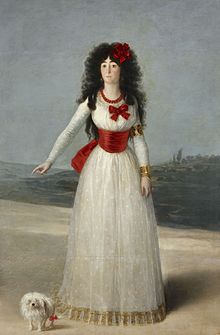Liria Palace
The Liria Palace (Spanish Palacio de Liria ) is a city palace in Madrid and since the beginning of the 19th century the official residence of the House of the Dukes of Alba in Madrid; The palace, built in the neoclassical style at the end of the 18th century, houses one of the most important private art collections and historical archives. With over 200 rooms on 3500 m² and its gardens, the palace is the largest privately owned residence in Madrid and is only surpassed in size by the Palacio Real .
background
The palace was commissioned by Liria- born (hence the name) James Fitz-James Stuart, 3rd Duke of Berwick, a descendant of James Fitzjames, 1st Duke of Berwick , who was known for his successes in the War of Spanish Succession in 1707 in the Spanish duke was raised and also held the title of Duke of Liria; It was originally built from 1767 under the French architect Louis Guilbert and completed after 1771 by the architect Ventura Rodríguez . In the early 19th century the palace passed into the inheritance of the House of Alba after Maria Cayetana de Silva, 13th Duchess of Alba died childless and her title of 14th Duke of Alba to her great-nephew, who was also the 7th Duke of Berwick passed over. Eugénie de Montijo , last Empress of the French and aunt of the Duke of Alba at the time, died here in exile in 1920.
At the beginning of the 20th century, the well-known English architect Edwin Lutyens was commissioned with a modernization, but the work was not carried out immediately. The entire building burned down in the Spanish Civil War in 1936, with the exception of the façades. a. had been relocated to the Prado Museum , the Banco de España or the British Embassy. The palace was rebuilt from 1948 by Jacobo Fitz-James Stuart, 17th Duke of Alba, and his daughter Cayetana Fitz-James Stuart , 18th Duchess of Alba, who ran the House of Alba from 1955 to 2014, partly using the Lutyens plans. Although the 18th Duchess of Alba had her official residence in the Liria Palace, she later preferred the Palacio de las Dueñas in Seville, where she died. Her son and heir Carlos Fitz-James Stuart, 14th Duke of Huéscar, still lives in the Liria Palace to this day.
Art and documents
The art collection includes paintings from the Spanish school (including Goya (portrait of the 13th Duchess of Alba), El Greco , Zurbaran and Velázquez ), as well as Italian, Flemish (including Rubens ) and French schools, as well as a number of portraits by Franz Xavier Winterhalter . Historical documents can be viewed in the library, including a. handwritten notes by Christopher Columbus, a first edition of Don Quixote, the first Bible written in Castilian, as well as various nobility privileges and certificates (including the privilege granted by the Spanish King Felipe V in 1707 to the Marshal of Berwick for his victory in the battle at Almansa the Duchy of Liria and Xérica ), correspondence of the family with historical figures and various documents of the Empress Eugénie de Montijo.
Visits
The privately owned palace was only opened to a wide audience in September 2019; Since then, guided tours of the state rooms and the library can be reserved online.
Web links
- Palacio de Liria (website, with the option to reserve tickets)
- Fundacion de la casa de Alba (website of the House of Alba Foundation)
Coordinates: 40 ° 25 ′ 39.7 " N , 3 ° 42 ′ 44.6" W.


